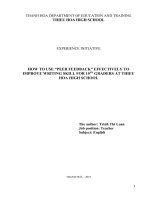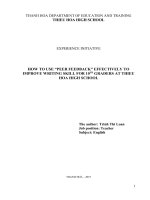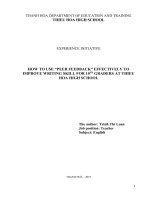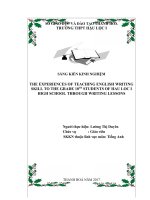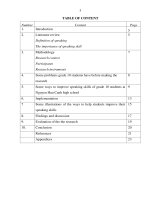skkn cấp tỉnh applying some strategies to improve listening skills for 10th graders at hau loc i high school
Bạn đang xem bản rút gọn của tài liệu. Xem và tải ngay bản đầy đủ của tài liệu tại đây (673.64 KB, 27 trang )
<span class="text_page_counter">Trang 1</span><div class="page_container" data-page="1">
<b>THANH HOA DEPARTMENT OF EDUCATION AND TRAININGHAU LOC I HIGH SCHOOL</b>
</div><span class="text_page_counter">Trang 2</span><div class="page_container" data-page="2"><b>TABLE OF CONTENTS Page</b>
<b>PART 1: INTRODUCTION...</b>
1.1. Rationale...1
<b>1.2. Aim of the research...3</b>
<b>1.3. Objectives...3</b>
<b>1.4. Scope of the research...3</b>
<b>PART 2: THEORETICAL AND PRACTICAL BACKGROUND...</b>
2.1. What are listening skills ?...3
2.2. Some strategies to improve students’ listening skills...5
<b>PART 3: HOW TO IMPROVE LISTENING SKILLS FOR 10<small>TH</small> GRADERS</b>3.1. Adaptable exercises………....13
3.2. Exercises Incorporating Technology...17
<b>3.3. Follow-Up and Feedback……… ……18</b>
<b>PART 4: RESULTS AND EVALUATION...20</b>
<b>4.1. Results...20</b>
4.2. Evaluation...22
<b>PART 5. CONCLUSION...23</b>
<b>REFERENCES...</b>
</div><span class="text_page_counter">Trang 3</span><div class="page_container" data-page="3"><b>PART 1: INTRODUCTION1.1. Rationale</b>
<b>1.1.1. The necessity of applying strategies to improve listening skills in English10 Global success for students:</b>
At High Schools, as teachers, we may find ourselves in a challenging position due toa lack of effective teaching methods tailored to improve listening skills. Traditionalteaching has often emphasized speaking, reading, and writing, leaving listening skillsunderdeveloped. Recognizing this gap is the first step toward addressing the issue.Teachers may currently rely heavily on textbooks and written exams, which do notsufficiently engage the listening abilities of students. Before new strategies areapplied, there must be an honest evaluation of existing teaching practices and awillingness to adapt to more auditory and interactive methods of instruction.
Adapting to the students' levels is also a crucial factor that requires attention. It'spossible that previous one-size-fits-all approaches have not met the diverse needs oflearners, especially those who might struggle with auditory processing or who areEnglish language learners. Therefore, I find that teachers in general and teachers atHau Loc I High School in particular need to be equipped with diagnostic tools toassess the individual listening capabilities of their students, enabling them to createdifferentiated instructional plans. Professional development opportunities can becrucial in providing teachers with the latest educational strategies and technologies totailor their methods to various student levels and learning styles.
<b>1.1.2. The current situation of training listening skills for students at Hau Loc Ihigh school:</b>
The 10th graders at Hau Loc I High School display a range of challenges when itcomes to listening skills. Many may be weak in this area due to a lack of practice andexposure to environments that require active listening. In a digital age where visualstimuli often overshadow auditory information, students may find it increasinglydifficult to maintain focus on purely auditory tasks. This deficit can be exacerbatedby the prevalence of background noise and distractions from mobile devices andother technologies, which can impede students' ability to listen attentively andprocess spoken information effectively.
In anticipation of applying strategies to improve these skills, it is vital to firstunderstand the students' current listening habits. For instance, they may rarelyencounter situations where listening is valued outside of passive activities, likelistening to music or watching videos. Addressing this gap requires incorporatinglistening practice into their daily routine in a manner that is both engaging andeducational. This may involve integrating podcasts, audiobooks, and interactivelistening exercises into their coursework. Moreover, providing students with activelistening strategies—such as note-taking, summarization, and questioning—canempower them to become more engaged listeners.
</div><span class="text_page_counter">Trang 4</span><div class="page_container" data-page="4">For a successful intervention, it will be important to foster a listening-richenvironment at Hau Loc I High School. The study could explore the use of a"listening corner," regular listening quizzes, and the integration of listening tasks intoother subject areas. The goal is to make listening an active part of every classroom,thereby providing the students with ample opportunity to practice and improve theirlistening skills.
Implementing these strategies will require a coordinated effort and commitmentfrom both teachers and students. Teachers will need to be proactive in learning andapplying new teaching strategies, while students will need to be motivated to embracethese changes and recognize the value of improved listening skills in their academicand personal lives. With careful planning and implementation, it's possible to create apositive shift in the listening culture at Hau Loc I High School.
<b>1.2. Aim of the research</b>
To help students in class 10A6 improve listening skills when learning new English10 in Global success textbook.
<b>1.3. Objectives</b>
In order to achieve the above aim, the writer will:
(1) - Investigate to identify the current state and the problems that many teachersand students are facing in teaching and learning listening skills.
(2) – Introduce some innovative strategies which can help students improve theirlistening skills.
(3) - Analyze the effects of the strategies on students’ listening ability.
<b>1.4. Scope of the research</b>
Beside the introduction and the conclusion, this research consists of three parts:- Theoretical and practical background
- Applied strategies to better students’ listening skills - Results and evaluation
<b>PART 2: THEORETICAL AND PRACTICAL BACKGROUND</b>
2.1. What are Listening Skills?
<small>Listening is a critical skill in language acquisition and overall educational development. Itenables students to absorb information, engage in communication, and participate fully inboth academic and social settings. For 10th graders, who are at a transitional stage in theircognitive and social development, effective listening skills are essential for understandingcomplex academic content and for successful interaction in higher education and beyond(Brown, 2015). As such, enhancing listening skills can significantly impact students'academic performance and interpersonal relationships.</small>
</div><span class="text_page_counter">Trang 5</span><div class="page_container" data-page="5"><small>Despite the importance of listening, many students face significant challenges that hindertheir ability to effectively process and comprehend auditory information. These challengescan stem from a variety of sources including cognitive overload, lack of motivation, limitedexposure to diverse listening situations, and specific individual learning needs (Smith &Jones, 2018). For 10th graders, these difficulties are compounded by the distractions oftechnology and social pressures, which can detract from active listening and engagement inclassroom settings.</small>
<small>Educational research suggests several effective strategies for improving listening skillsamong high school students. These include the use of multimedia and technology to createimmersive listening experiences, differentiated instruction tailored to individual studentneeds, and explicit teaching of listening strategies such as note-taking, summarizing, andquestioning (Doe, 2017). Implementing these strategies in a structured manner can helpeducators address the diverse needs of 10th graders and enhance their ability to listenactively and effectively.</small>
<small>In the context of 10th grade students at Hau Loc I high school, applying these listeningstrategies requires careful consideration of the local educational environment and studentdemographics. Techniques such as collaborative listening exercises, where students work ingroups to listen and then discuss and analyze the content, can promote engagement andfacilitate deeper understanding (Chen, 2019). Furthermore, incorporating feedbackmechanisms where students reflect on their listening experiences and outcomes can fosterself-regulation and improvement in listening skills.</small>
<small>By integrating these targeted strategies into the 10th-grade Global success textbook, it isanticipated that students will demonstrate improved academic performance, enhancedengagement, and better interpersonal communication skills. Moreover, these improvementsin listening abilities are likely to have long-term benefits, preparing students for success infurther education and in their future careers (Taylor & Lee, 2021).</small>
<b>2.2. Some Warm-up activities for improving listening skills:a. "What did you hear?"</b>
This activity is designed to sharpen students' focus and help them pay attention todetail in auditory information. Before beginning the main lesson, the teacher plays ashort audio clip, which could be a piece of music with complex layers of instruments,or a snippet from a dialogue with background noise. After listening to the clip,students are asked to write down everything they can recall from what they heard.
</div><span class="text_page_counter">Trang 6</span><div class="page_container" data-page="6">This can include words, phrases, the number of speakers, emotions conveyed,specific sounds of instruments, or background noises.
The complexity of the clip can be adjusted according to the students' level. Forexample, for more advanced students, the clip might include subtle sound effects oridiomatic expressions. After the exercise, the class can discuss what they heard, andthe teacher can play the clip again, helping students realize what they might havemissed the first time. This reinforces the importance of listening carefully and showshow easy it is to overlook details.
For example: For a unit focused on "Family Life- Unit 1" you can craft "What DidYou Hear?" warm-up activities that are specifically designed to prime students for thevocabulary and themes they will encounter in the unit. Here's a detailed approach forsuch an activity:
<b>Warm-Up Activity: "What Did You Hear?" - Unit 1: Family Life</b>
<small></small> A worksheet with a blank space for notes or a series of questions basedon the clip.
<small></small> After the first listening, give students a minute or two to jot downeverything they remember hearing, focusing on family-related terms,descriptive language, and any specific details about the scenariopresented in the audio.
</div><span class="text_page_counter">Trang 7</span><div class="page_container" data-page="7"><i>A group is recalling family-related terms</i>
Targeted listening:
<small></small> Hand out the worksheets with specific questions related to theaudio. These might include questions like "what does the mother in theclip say about dinner preparations?" or "list three adjectives that describethe children's behavior."
<small></small> Play the clip again. This time, students should listen for theanswers to the specific questions provided.
<i> Students in class 10A6 are listening to the clip and answering questions</i>
Discussion and feedback:
</div><span class="text_page_counter">Trang 8</span><div class="page_container" data-page="8"><small></small> Once the second listening is complete, have students share theiranswers in pairs or small groups, discussing any differences in what theyheard.
<small></small> Conduct a whole-class discussion, going over the worksheetanswers and highlighting any commonly missed details. This discussionhelps students realize the importance of paying attention to specifics inlistening tasks.
<small></small> For students who grasp the task quickly, challenge them withinferential questions like, "what can you infer about the family’srelationship from the conversation?" or "what time of day do you think itis, and why?"
<small></small> At the end of the warm-up, reinforce the vocabulary and phrases learnedby connecting them to the day’s lesson. This not only warms up their listeningskills but also integrates new language in a meaningful context.
<small></small> This warm-up exercise helps students to be actively engaged in listening.
<small></small> It encourages them to pay close attention to vocabulary and phrases thatwill be relevant to their current unit.
<small></small> It enhances their ability to identify main ideas and details in spokenlanguage, which is a critical skill for real-life listening and communication.By tailoring the "What Did You Hear?" activity to the "Family Life" unit, studentsare not only practicing their listening skills but also reinforcing their unit-specificvocabulary and conceptual understanding, making the warm-up activity bothpractical and thematic.
<b>b. "Two truths and a lie"</b>
This classic icebreaker also serves as an excellent warm-up activity for enhancinglistening skills. Each student thinks of two true statements about themselves and onefalse statement (the "lie"). One by one, students share their three statements with theclass, and their classmates listen closely to try and deduce which statement is the lie.This activity demands careful listening, as students often include subtle hints orimprobable truths to trick their listeners. It also adds an element of personalengagement, as students learn about each other's experiences and interests, which canincrease motivation and attention.
<b> Warm-up activity: "two truths and a lie" - Unit 2: Humans and the</b>
To engage students' listening and critical thinking skills by discerning factualstatements from falsehoods about human interaction with the environment.
</div><span class="text_page_counter">Trang 9</span><div class="page_container" data-page="9">Materials needed:
<small></small> None required, but you may choose to use a whiteboard or projector tolist the students' statements if it’s a large class.
Introduction to the theme:
<small></small> Introduce the "two truths and a lie" activity with an environmentaltwist. Explain that all statements should be related to humans and theirrelationship with the environment. This could include facts aboutpollution, conservation efforts, climate change, etc.
<small></small> Give students a few minutes to come up with two true statementsand one false statement about humans and the environment. Theseshould be based on their previous knowledge, what they learned in unit1, or even common knowledge they might have about environmentalissues.
<small></small> Students take turns sharing their three statements withoutrevealing which one is the lie. Encourage them to be creative with theirtruths and clever with their lie to make it challenging for their classmatesto guess.
Listening and guessing:
<small></small> After each student presents their statements, the rest of the classlistens carefully and votes on which statement they believe is the lie.Encourage students to justify their choices, fostering a discussion onwhy they perceive certain statements as false.
Revelation and discussion:
<small></small> The student reveals the false statement and briefly explains thetruths behind the accurate statements. This step is crucial for reinforcinglearning about environmental issues and correcting any misconceptions.Extension:
<small></small> For an additional challenge, students can be asked to providesources for their truths after all guesses have been made, emphasizingthe importance of reliable information when discussing environmentalissues.
<small></small> Conclude the warm-up by reflecting on the variety of issues brought upthrough the activity. Highlight how these issues will relate to what they aregoing to learn in Unit 2.
</div><span class="text_page_counter">Trang 10</span><div class="page_container" data-page="10"><small></small> Use this opportunity to introduce the specific topics of the unit, such assustainable practices, the impact of deforestation, or the concept of carbonfootprint.
<i><b>A student is sharing information related to the topic The environment</b></i>
Adapting "Two Truths and a Lie" to the "Humans and the Environment" unit turns asimple warm-up game into a thematic, informative, and interactive start to the class.It prompts students to engage with the material on a personal level, as they share andanalyze information relevant to the unit's topics.
<b>c. "Word repetition"</b>
The "Word Repetition" activity is a dynamic way to improve memory and listeningskills simultaneously. The teacher starts by saying a word or phrase, and then selectsa student to repeat that word or phrase and add one of their own. The followingstudent must then repeat everything that has been said so far, in the correct order, andadd another word or phrase to the chain. This continues around the classroom,becoming progressively more challenging as the list grows longer. The repetitivenature of the activity means that students must listen intently to their classmates,reinforcing their concentration and recall abilities.
<b>Warm-Up Activity: "Word Repetition" - Unit 3: Music</b>
</div><span class="text_page_counter">Trang 11</span><div class="page_container" data-page="11">Vocabulary introduction:
<small></small> Begin by introducing or reviewing key musical terms that studentswill encounter in unit 3. Write these on the board or project them onto ascreen.
Starting the activity:
<small></small> The teacher starts the activity by saying a word from the list, suchas "melody."
Student participation:
<small></small> The first student repeats the initial word "melody" and then addsanother word from the list, like "harmony." the next student then repeats"melody, harmony," and adds another word, such as "rhythm,"continuing the pattern.
Building memory chains:
<small></small> Continue around the class, with each student repeating the chainof words in sequence and adding one more. This will create a long stringof musical terms that each subsequent student must remember and recite.Support and challenge:
<small></small> If a student struggles to remember the sequence, the class can helpout, but encourage the student to try again on their own to reinforce theirlistening and memory recall.
<small></small> To increase the challenge, ask students to not only repeat thewords but also to provide a brief definition or example of each term asthey go along. For instance, when a student adds "genre," they could say,"genre, like jazz or blues."
Engagement with music elements:
<small></small> Incorporate a clap or a snap to represent certain musical elementswhen they are mentioned. For example, students could clap for 'rhythm'or snap for 'melody', adding a kinesthetic element to the exercise.
<small></small> Discuss how the repetition and the sequence help in memorizing andrecalling terms.
</div><span class="text_page_counter">Trang 12</span><div class="page_container" data-page="12"><small></small> Connect the terms to the topics they will cover in Unit 3, such as howrhythm is foundational to a music piece or how different instruments contributeto harmony.
This adaptation of the "Word Repetition" activity for a music unit actively engagesstudents in a comprehensive listening and learning exercise that is both educationaland enjoyable, perfectly setting the stage for a deeper exploration of musicalconcepts.
<b>d. "Sound Bingo"</b>
"Sound Bingo" is an interactive and engaging warm-up that prepares students forthe topic of the day's lesson. The teacher prepares bingo cards in advance, with eachsquare containing a word or phrase that will be mentioned during the class. As thelesson progresses, students listen out for these words or phrases and mark them off ontheir cards. The first student to mark off a complete row or column wins a small prizeor recognition. This activity encourages students to listen for specific information andcan be especially useful in lessons where new vocabulary will be introduced. It alsoadds a gamified element to learning, making the act of listening both fun andcompetitive.
<b>Warm-Up Activity: "Sound Bingo" - Unit 4: For a Better Community</b>
<small></small> A list of sentences or a dialogue prepared by the teacher that naturallyincludes the terms on the bingo cards.
Bingo card distribution:
</div><span class="text_page_counter">Trang 13</span><div class="page_container" data-page="13"><small></small> Hand out the "sound bingo" cards to each student. Ensure thateach card has a different arrangement of the terms to maintainuniqueness for each participant.
Introduction of concepts:
<small></small> Briefly explain the importance of the terms on the bingo cards andhow they relate to building a better community. This primes students forthe listening task and the unit's subject matter.
Listening task:
<small></small> Read out sentences, tell a story, or play a recorded dialogue thatcontains the words and phrases found on the bingo cards. Speak clearlyand at a moderate pace to allow students to catch each term.
Marking the cards:
<small></small> As students hear the terms being mentioned, they mark them ontheir cards. They should be attentive, as some terms might be easilymissed if they're not listening closely.
Winning the game:
<small></small> The first student to mark off a complete row, column, or diagonalshouts "bingo!" and reads out the terms they have marked. The teacherverifies that the terms were indeed mentioned.
<small></small> Connect the terms to specific upcoming projects or themes within theunit, such as a class volunteer project or a discussion on community leadership.Benefits:
<small></small> "sound bingo" promotes careful listening as students must distinguishbetween different terms and be able to recall them quickly.
<small></small> It introduces and reinforces vocabulary in an enjoyable and competitivemanner.
<small></small> The game format can motivate students by tapping into their competitivespirit, making learning more engaging.
This "Sound Bingo" activity tailored for a unit on community engagement providesa fun and educational way to start the lesson, focusing on the importance of each
</div>

